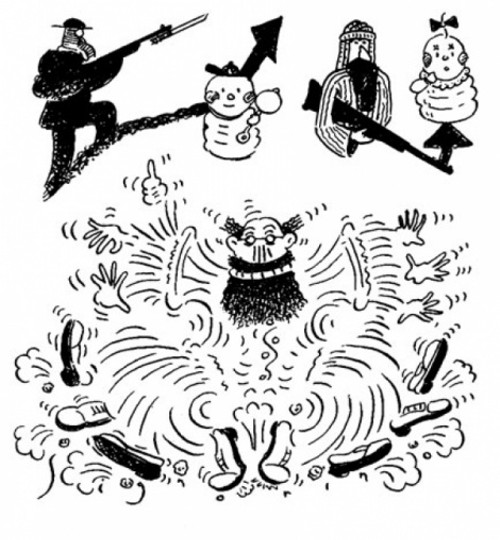A colleague recently told me that after wars, the male-female ratio at birth increases. I looked around and found several articles mentioning the phenomenon but none explaining it. Any truth to this? —Edgard
Your columnist hates these statistical questions, although not because I have a problem with statistics. On the contrary, I regard numbers with a love that’s holy and pure, although I do get a little sweaty thinking about closely fitting my data to a curve.
My beef is with statisticians. These people happily fill pages with tables, Greek letters, and terms like “slowly decaying autocorrelation,” which sounds like something out of Dawn of the Dead. Then, the next guy comes along and says Mr. Autocorrelation used the wrong data set, the schmuck. So you’ll forgive me if I don’t offer a definitive answer, but instead merely describe the current confused situation. Let’s take it step by step.
1. The natural sex ratio is about 1:1. Duh, you say. Come now—every schoolboy knows you could maintain the species with a handful of males to service the available females, and most would be happy to try. In the real world, however, the forces of natural selection militate in favor of roughly equal numbers of girl and boy babies. This is called Fisher’s principle, after Ronald Fisher, the English biologist and statistician who explained it all in 1930.
2. The observed sex ratio at birth isn’t in fact 1:1, but more like 105 males to 100 females. Good thing. What with car wrecks, power-tool accidents, and other masculine mishaps, the ratio declines to 1:1 during adulthood.
3. Even the 105:100 ratio is a pretty loose approximation. The actual number can vary from 103 to 107, sometimes more widely, from region to region and year to year. One alleged variation, getting back to your question, is that more boy babies are born after a war. The simplest explanation for this comes from the 18th-century German demographer and theologian Johann S%uFFFDssmilch, who proposed that God was compensating for soldiers who got killed.
4. Among the more recent proponents of the war-equals-additional-boys effect are Jan Graffelman and Rolf Hoekstra. In a 2000 study, they analyzed birth data for the United States and selected European countries from the mid-1800s onward, focusing on the First and Second World Wars. Verdict: there was an uptick in wartime and postwar male births in 8 of 10 belligerent countries, but it was small—just 0.15 percent. This works out, for example, to 950 extra boys in the Netherlands in 1942 and 1,800 extra boys in France in 1943. Considering the tens of millions slaughtered over the period under study, you have to ask: Who gives a fluke about a few births?
5. At this moment of ennui, we happened on a 2009 paper by geneticist William James, who was more our kind of guy. He pointed out that sex ratios trend slowly but significantly up and down over extended periods of time for reasons nobody really understands. So if you look mainly at the long sweep of history, short-term fluctuations get lost in the weeds. Better to compare wartime and postwar periods with the immediately adjacent years. The best way to do that wasn’t complicated technical analysis, %uFFFD la Graffelman and Hoekstra; rather, you just needed to eyeball the graphs.
6. With that in mind, James proceeded to review numerous conflicts. You’re wondering about the effects of the Russo-Swedish war of 1789-’90? Birth ratio-wise, it didn’t do squat. Likewise for the Napoleonic Wars, the Franco-Prussian War, etc. In fact, just about the only conflicts clearly marked by fluctuations were A., the First and Ssecond World Wars, where the male birth ratio went way up in some countries, and B., the Iran-Iraq war of the 1980s, where in Iran it went way down—in fact, more girls were born than boys.
7. An ordinary person might think this is a fatal flaw in my hypothesis. Not James. He reasoned that when the sex ratio jumps either way, it’s something we need to explain. Dismissing poor nutrition, birth order, maternal age and other dull factors, James propounded an explanation with more entertainment value: coital rate. Briefly put, if couples have frequent sex when the male is home on leave, or during the giddy celebration at war’s end, the result—for reasons having to do with the timing of conception during the menstrual cycle—is more baby boys. Meanwhile, he blamed the low male birth ratio in Iran on maternal stress, which apparently leads to more miscarriages of boys. A supporting data point: The male birth rate in New York City dropped in the wake of 9/11.
Interesting, but the impartial observer is obliged to say that if wartime birth ratios sometimes go up, sometimes go down, but mostly stay the same, the obvious explanation is that this so-called phenomenon doesn’t really exist. But how much fun is that? Cecil sympathizes with James’ approach: When faced with uncooperative data, get out there and dance.
Send questions to Cecil via StraightDope.com or write him c/o Chicago Reader, 11 E. Illinois, Chicago 60611. Subscribe to the Straight Dope podcast at the iTunes Store.
More by Cecil Adams
-
This Is the End, My Friend
This week's Straight Dope marks the last appearance of the column as the Teeming Millions have known it for the past 45 years.
- Jul 11, 2018
-
Do Brain Supplements Do Anything?
Brain Drain
- Jul 4, 2018
-
Is flying really worse for the environment than driving?
Planes and Trains
- Jun 27, 2018
- More »




